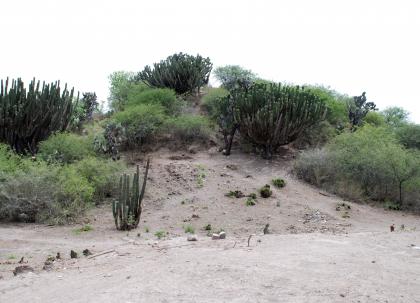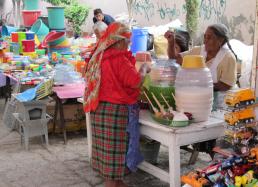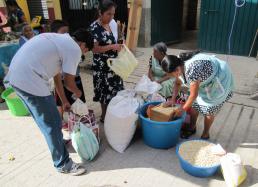9. Questions for Future Investigations
A field season that began with a lengthy delay and great disappointment is now wrapping up with incredible findings and unbridled anticipation, not to mention a bevy of questions to address and hypotheses to test during planned future investigations at Lambityeco.
Some of these questions include: How typical is Mound 165 at Lambityeco? What exactly was the relationship between Mound 165 and the adjacent temple mound (see above photo)? How significant was the proposed shift in the relative importance of different Zapotec supernaturals (and the rites and rituals associated with them) in distancing outlying centers, such as Lambityeco, from Monte Albán after A.D. 700? During this period, what role did the salt produced at Lambityeco have in allowing the leaders of the site to forge their own links and networks with people and places inside, and possibly outside, the Valley of Oaxaca?
Linda and I are excited by the prospect of continuing these studies and look forward to strengthening our collaboration with INAH colleagues at Lambityeco and the Oaxaca Central Offices. We’re also eager to help present and translate our findings both to the people whose histories and heritage we’re researching, as well as the many visitors from around the world who have the chance to explore this beautiful and historically rich valley.
Today, Jessica, Lacey, Linda, and I are wrapping up a few final project odds and ends, such as printing our preliminary report on this year’s study and downloading the last tape from the movie camera, in preparation for all of our departures next week. Linda and I will be driving back as always, hopeful that the return trip is as uneventful as the journey here was.
We’re looking ahead to a late-morning visit to the Sunday market at Tlacolula, which is something that we relish each season (see Photos #1 and #2 below.) Years ago, at this same weekly market, some residents of Tlacolula still made brown salt from the briny sediments at the south end of Lambityeco. Although that economic pursuit—which likely sustained the people of Lambityeco (and its sister site, Yegüih) from times even before the foundation of Monte Albán (ca. 500 B.C.)—is no longer practiced much today, if at all.
Like so many other pursuits that once were important for daily lives here—such as the making of rope and clothing from maguey fibers, and even the making of simple earthenware vessels—our knowledge of these practices and their histories pretty much can be made vivid and brought alive today only through archaeology, which also provides the geographic and cultural context so essential for their understanding.
Farther up the road, we hope to have this opportunity to share our findings and thoughts with you next year. In any event, we thank you for following along with our pitfalls, successes, and hypotheses, and we welcome your feedback and suggestions.
Until next year,
Gary




